 Browns Archive
Browns Archive  Browns Game Vault: 10/10/76. HC Forrest Gregg, and the Turkey Jones Game
Browns Game Vault: 10/10/76. HC Forrest Gregg, and the Turkey Jones Game
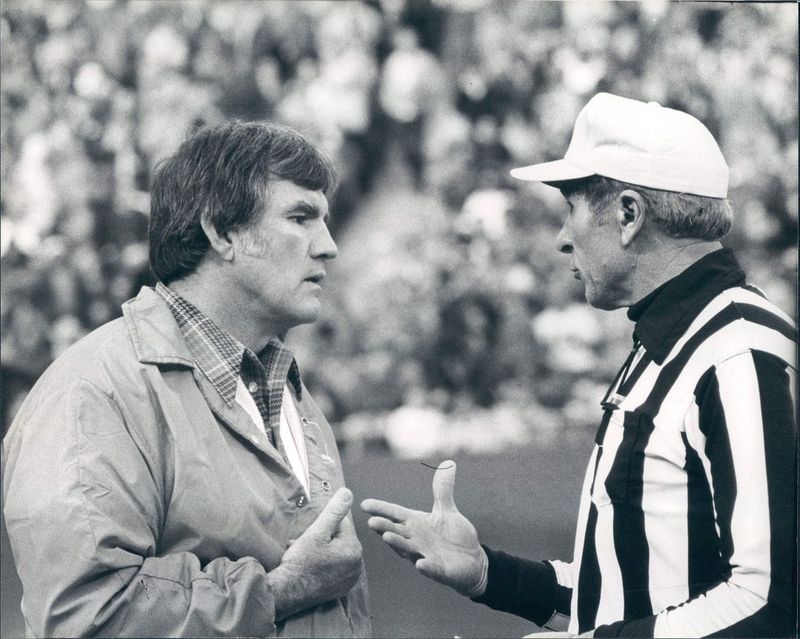 I saw an old acquaintance at the grocery store the other day.
I saw an old acquaintance at the grocery store the other day.
“Hey, how have you been?” I hadn’t seen him in three years- since his oldest son and my older daughter were seniors in high school. His son was a jock, and we attended all the football and basketball games because our daughter was a cheerleader. So for years, I saw this guy once or twice a week. We never really got to know each other, but there was plenty to talk about with our kids. “How is Nate?”
“He’s doing great. He’s living down by the college, Ohio Street, going to school.”
“Great. I know exactly where you are talking about. One of my old haunts.”
“Yeah… He’s been married a year now. They’re a good fit. She’s great for him, we love her a lot.”
Ooooh, ouch. Way too early. “Great.” I blinked, consciously averting my eyes. But I’m probably the only person that can be a deer-in-the-headlights without actually looking. Of course, it’s only my opinion. Who knows, maybe when they each inevitably change over the next few years, they’ll change together. Could happen.
“Well, I wish you guys well. See ya!”
That’s parenting for you. We love our kids. Yet early on, we lose the ability to shape their personality. Then, their decisions. We love them through the growing years- and it doesn’t stop there.
***
When Forrest Gregg became a pro football coach in the early 1970s, he began a somewhat scattered career path. He began as an assistant, the offensive line coach in San Diego in 1972 and 1973. That team wasn’t very good (although they were about to draft QB Dan Fouts out of Oregon, which would improve their fortunes), and much of the staff was let go. Gregg felt the need to look for another position to ensure he would remain employed.
Art Modell of the Cleveland Browns called. He and HC Nick Skorich (a previous coach of Gregg’s) personally interviewed Gregg, and made an offer. Gregg accepted, and has said he was excited to coach in Cleveland, Ohio: in his words, “the heart of football”. Gregg looked forward to being a part of one of the great franchises of the NFL.
Of course, Forrest Gregg was not your average-player-turned-coach. He was an All-Pro offensive lineman who’d been a six-time NFL champion, mostly with the Green Bay Packers. Legendary coach Vince Lombardi had called him “the finest player I ever coached.”
So despite his outstanding career as a player, Gregg was now working his way up the ladder, pretty much like most of the rest of us. He went about his development as a coach with the earnest determination that marked his playing career. The decisions he made were as part of a team, with his wife’s input and his kids’ welfare in mind.
***
Driving home, I began to reminisce on the days of our girls’ youth. I remembered all the times I turned off lights, when nobody was using them. I could turn off lights in four rooms without anyone noticing the difference. I wasn’t so worried about the electricity, but I didn’t much like replacing bulbs. We seldom had enough replacements, and this was in the not-so-distant days of the old, short-life bulbs.
I smiled as I recalled the time I got a brainstorm. I was going to begin purchasing motion-sensor light switches. I tried it out- I bought one such switch and installed it in the girls’ bathroom. That room was windowless, and its lights were always on. I was really proud of myself: now, the kids could enter and exit their bathroom at will, and there was no longer a need to turn the light on or off. The new switch had it handled, and that little aggravation was removed from my life.
That is, until the first time our younger daughter used the bathroom. It was shower time, which could take a while. As she stood behind the curtain, the motion sensor wasn’t sensing motion- and turned off the light. Pitch black. The terrified scream from the second floor bathroom could be heard from every remote corner of the house.
The old light switch was reinstalled later that day. Bad idea!
***
In 1974, Forrest Gregg guided the Browns’ offensive line as Nick Skorich’s team sunk to the worst record in its history, at 4-10. Skorich had taken the Browns to 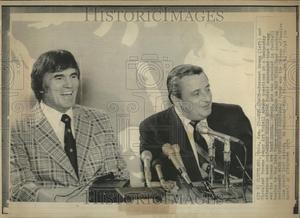 the playoffs in 1971 and 1972, but it seemed clear that fans and writers alike believed the team needed a new head coach. Art Modell interviewed Monte Clark, the offensive line coach of the Miami Dolphins, and Forrest Gregg. Modell asked Gregg for his take on the team- did it need a complete rebuild? Gregg, honest as ever, diplomatically explained that they did need players, but that a total makeover was unnecessary.
the playoffs in 1971 and 1972, but it seemed clear that fans and writers alike believed the team needed a new head coach. Art Modell interviewed Monte Clark, the offensive line coach of the Miami Dolphins, and Forrest Gregg. Modell asked Gregg for his take on the team- did it need a complete rebuild? Gregg, honest as ever, diplomatically explained that they did need players, but that a total makeover was unnecessary.
Gregg had other thoughts, as well. It was paramount that the team be in great physical condition. He was going to be extremely demanding, but the players were going to like winning. And that was what he planned to do. Also, there was one part-time player who would get a chance to play full-time. “That little running back, Greg Pruitt.”
Gregg knew he had a good chance to be chosen, due to Modell’s hiring “from within the team” in the past. Modell’s method of decision-making was to float an idea out to the local sportswriters and see how it was received. When Modell announced that Forrest Gregg was the leading candidate to be the next Browns head coach, the writers’ reaction was positive. As was the fans’. Gregg’s offensive line agreed (they’d been won over after some early raised eyebrows from being driven hard). Marie Lombardi, Vince’s widow, also called Modell and put in a good word for Gregg.
Art Modell was a creature of public relations; there was no way he wasn’t going to hire Forrest Gregg now. He informed Gregg that he was the man. The coach noted that ironically, his schedule immediately filled up with duties that had nothing to do with actual coaching. Shopping for a suit; appearing for interviews; extra meetings. Gregg kept a few of the previous regime’s assistants. Gregg liked Modell’s suggestion that he ask Blanton Collier to be the quarterbacks coach. Collier was the head coach prior to Skorich taking over in 1971, and the playbook they used was his. Collier had been forced to resign- during a game- due to hearing loss that had worsened over his lifetime. The old coach would be a big help to the new coach.
Did I mention Art Modell was public-relations oriented? He inserted himself into the Browns’ new training camp setup, arranging blocking sleds and other items in a way to make the scene aesthetically pleasing to observers. But camp quickly became Gregg’s. He was determined to demand 100% of each player. It was a shock to most, who were used to the laid-back Skorich. But most of the players bought into the program. 1975 saw the Browns end up at 3-11, but the groundwork was laid for improvement in 1976.
***
Twelve years. That is all we get, as parents, in molding the personalities of our children. This tight window only heightens the stakes as we do our best job in raising them.
I laugh when I hear fathers at my work, talking tough about their pre-school aged daughters. Oh, yeah- when boys start coming around, these dads will be cleaning their guns, or sharpening their knives. That will provide their intimidation. Fine- whatever helps you sleep at night. But the kinds of situations, or troubles, your daughter gets into one day has a lot more to do with your twelve years than it does with those boys. If a father neglects his daughter, she might grow up needy- allowing herself to be used by boys. But if a father superficially spoils her, she could end up treating boys like toys, using and discarding one after another. The girl controls most situations. Think about it, husbands: you didn’t pick your wife. She LET you pick her. You married ‘up’.
If you are present and fully engaged in your daughter’s life through those twelve years, you both will be fine.
***
As he moved his family to Cleveland, Forrest Gregg’s thoughts often turned to his kids. How would they take to the move from San Diego? His son was a team ball boy with the Browns. Offensive lineman Doug Dieken and others generally harassed the boy and his friends in a good-natured way, doing things like taping them up and stuffing them into trash cans. When the coach learned of this later, he was proud that his boy never told on the players.
Gregg maintains that when they are asked what were the cities they liked living in best, his kids say: San Diego and Cleveland. But there was a flip side to 1975; the coach had a mole on his leg that was found to be cancerous. (To his credit, here is where Gregg graciously leaves out some details of the Brown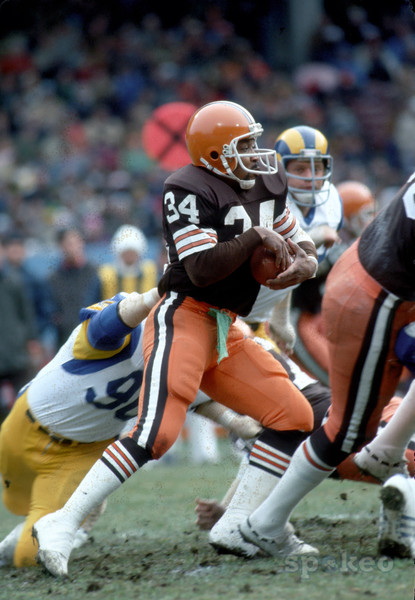 s organization breaching his privacy. There was a zeal to learn information on the coach’s health- there are details I cannot corroborate via a Google search but definitely recall hearing about years ago.) Gregg’s main concern? Of course: how would his children take the news. Cancer was a taboo subject back then- and in those pre-HIPAA days, hospital personnel were liable to speak freely and carelessly. Ultimately, Forrest Gregg beat the cancer.
s organization breaching his privacy. There was a zeal to learn information on the coach’s health- there are details I cannot corroborate via a Google search but definitely recall hearing about years ago.) Gregg’s main concern? Of course: how would his children take the news. Cancer was a taboo subject back then- and in those pre-HIPAA days, hospital personnel were liable to speak freely and carelessly. Ultimately, Forrest Gregg beat the cancer.
In 1976, the Browns drafted RB Mike Pruitt out of Purdue. They also signed Cleo Miller, to compliment Greg Pruitt. Gregg wanted to work Mike Pruitt into the system, although it was not soon enough for Modell. Gregg was (and remains) a true believer in Greg Pruitt. Early on, he’d play the small back over the course of a drive, and then take him out when they got down near the goal line. Eventually, he decided that Greg Pruitt needed to stay in and help finish off drives. It soon got to the point that he feared he was overusing him by also having him run back kicks and punts. To this day, Forrest Gregg- Hall of Famer- maintains that Greg Pruitt belongs in the Hall of Fame.
In Game One that season, the Browns looked good against the New York Jets. QB Mike Phipps was having a decent game. The Browns would win- but as he fought for extra yardage as he was being tackled, Phipps was injured. (I really get the feeling that Forrest Gregg liked Mike Phipps as a quarterback). A 13th round draft pick from 1972 was the backup- Brian Sipe. Sipe and the Browns struggled as they tried to find the winning chemistry.
In Week 5, the 1-3 Browns faced the two-time Super Bowl Champion Pittsburgh Steelers, at home in front of a full house. The Steelers had already crushed the Browns in Pittsburgh. However, Cleveland was beginning to assume the tough nature of its coach.
Sipe got knocked out of the game in the first half, with rookie QB Dave Mays taking over the offense.
The Steelers lost the services of their starting QB, as well. In the 4th quarter, DE Joe “Turkey” Jones (covered here) sped around the end on a speed rush and 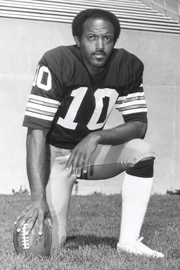 embraced Steeler QB Terry Bradshaw. Jones lifted Bradshaw, and in one motion turned him upside down and pile-drove him into the stadium turf. Bradshaw’s body spasmed, and it was fortunate he wasn’t seriously hurt. Browns fans roared, and Steeler fans cried foul. More fodder for the explosive rivalry.
embraced Steeler QB Terry Bradshaw. Jones lifted Bradshaw, and in one motion turned him upside down and pile-drove him into the stadium turf. Bradshaw’s body spasmed, and it was fortunate he wasn’t seriously hurt. Browns fans roared, and Steeler fans cried foul. More fodder for the explosive rivalry.
Here’s an interesting paragraph from Chuck Heaton’s 1976 Plain Dealer account of the game:
"Bradshaw was hurt when upended by Joe Jones who had his best day as a Brown. Jones was assessed 15 yards for unnecessary roughness on the play, but it seemed to be questionable call."
Mays (right), who held a degree in dentistry, was a 27 year old rookie (current Browns fans, insert comment here). He gutted out the victory, and was aided by the Browns blocking a field goal and an extra point off the foot of Roy Gerela. The Browns won, 18-16. That game would launch them into a 8-2 finish to the season. They would just miss the playoffs, but the season was cause for optimism for all of northeast Ohio.
Forrest Gregg was named NFL Coach of the Year by the Associated Press for 1976. In January of 1977, he learned of his election into the Pro Football Hall of Fame. It was the pinnacle of the Forrest Gregg era in Cleveland. For him, and his family.
Thank you for reading. Sources included Winning in the Trenches, a Lifetime of Football by Forrest Gregg and Andrew O’Toole, the online Plain Dealer Cleveland Browns game story database, Wikipedia.
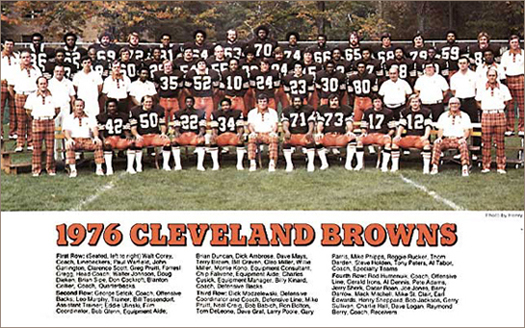
- NBA Announces 2013-2014 Schedule
- Browns Ink Sharknado
- Sharknado A No-Show For Rookie Camp
- Trent Richardson Out Until Training Camp
- Browns Sign Brandon Jackson
- Carrasco Suspended Eight Games
- Browns Add to Wide Receiver Depth with David Nelson
- Browns Need to Learn from Past Draft Mistakes
- Browns Release Chris Gocong and Usama Young
- Browns Missing on Grimes Disappointing, But Not The End
The TCF Forums
- Official- Browns Coach Search/Rumors
mattvan1 (Tuesday, January 21 2014 1:19 PM) - Movies coming out
rebelwithoutaclue (Tuesday, January 21 2014 12:56 PM) - 2015 Recruiting
jclvd_23 (Tuesday, January 21 2014 12:38 PM) - The 2014 Offseason Thread
Larvell Blanks (Tuesday, January 21 2014 12:25 PM) - Chris Grant's first 3 drafts
Kingpin74 (Tuesday, January 21 2014 10:13 AM) - Mike Brown
YahooFanChicago (Monday, January 20 2014 11:15 PM) - 2014 Hoops Hockey Hijinx
jpd1224 (Monday, January 20 2014 4:44 PM) - 2014 Recruiting
jclvd_23 (Monday, January 20 2014 2:26 PM) - Wish List - #4 Pick
Hikohadon (Monday, January 20 2014 1:26 PM) - #1 overall pick Anthony Bennett
TouchEmAllTime (Sunday, January 19 2014 1:28 PM)



